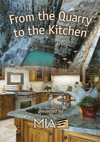It’s not worth getting into who is behind the latest version of this nonsense anymore, but let’s just say that there are some deep pockets involved. Moreover, the spread of misinformation is costing the stone industry a significant amount of money. Shortly after this latest smear campaign against granite, the Marble Institute of America (MIA) funded an independent study that - once again - concluded that granite is safe to use in kitchens.
The study, designed to determine whether radon gas sometimes released by natural stone poses any health risk, was conducted by an independent geochemistry researcher. Included in this study were 13 of the most popular types of granites used in countertop applications, representing up to 85% of the granite countertops sold in the U.S.
“This is the first time anyone has taken a comprehensive, scientific look at the array of granite actually being used in kitchens across the U.S.,” said L. L. Chyi, a Ph.D. and professor of Geology and Civil Engineering at The University of Akron in Ohio. “Based on the testing results and EPA standards, we can conclude that the most popular granites used as countertop surfaces pose no health threat to homeowners.” (A full release on the study and its findings can be found in this issue’s Newsline section on page 21.)
But even though the latest batch of misinformation about granite has been set aside with a healthy dose of the truth, the problem is not only the cost of funding these studies, but also to convey these results to the public. With this in mind, the MIA announced that it has created the “Truth About Granite Fund,” and it has been launched with a $5,000 inaugural gift from the Natural Stone Council and a matching pledge from Cold Spring Granite of Cold Spring, MN, according to Jim Hogan of Carrara Marble Company of America and the current president of the MIA.
“The misinformation campaign is being driven through front groups that purport to be consumer advocates, but are merely trying to create consumer fears about natural stone,” Hogan stated. “We must aggressively fight the unfounded fear mongering to reassure the public.”
Calling the anti-granite campaign a major threat to the granite portion of the natural stone industry, Hogan said the MIA has already invested $50,000 of unbudgeted funds to stem attempts to scare consumers about granite. He said that amount could increase dramatically by year’s end. “It is important that we have all the legal, technical, public relations and marketing/advertising tools we need to protect the good name of granite and to reassure consumers that granite is as safe as it is beautiful, durable and practical,” Hogan explained.
In a letter to MIA members, he stressed that the anti-granite campaign could create substantial financial losses for the industry if it is not challenged aggressively. “Your support is vital,” Hogan said, in asking for immediate pledges for the fund from quarriers, fabricators, distributors and others in the MIA and the rest of the natural stone industry.
As I said earlier, even though the latest scientific study released by the MIA has successfully refuted the misinformation about granite (once again), this effort is far from over. On behalf of our magazine, I would like to express our appreciation to the MIA for its swift response to this issue, and to the Natural Stone Council and Cold Spring Granite Co. for their financial contributions to this matter. This is an extremely worthy cause to fund, and I encourage industry members to offer whatever assistance they can provide.
The Truth About Granite Fund will be a special segregated account whose expenditures will be overseen by the MIA executive committee. Contributions to the fund should be sent to Marble Institute of America/Truth About Granite Fund at 28901 Clemens Rd, Suite 100, Westlake, OH 44145.




